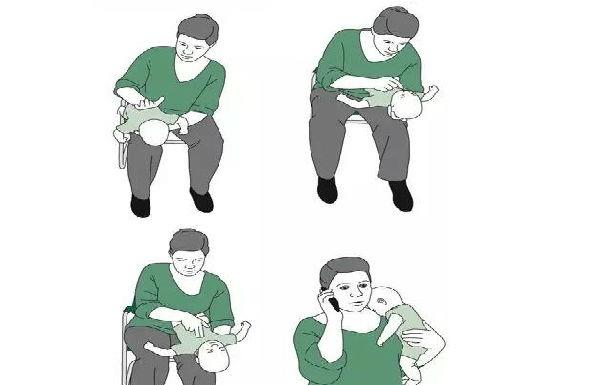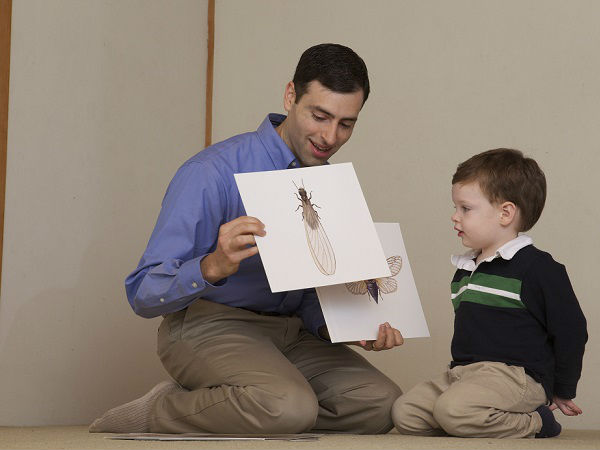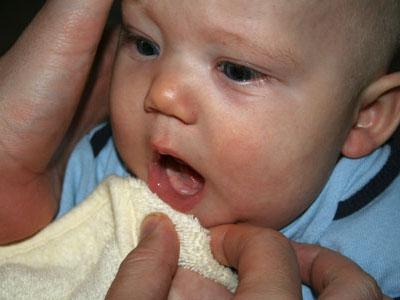Choking is one of the causes of airway obstruction in children, if not handled in time, it will leave many serious consequences. Therefore, parents need to equip themselves with some knowledge about how to handle choke when babies are choking milk. In case the baby choked on the milk, the mother was not too embarrassed and awkward to give first aid to the baby
content
How to handle choke baby milk
Why do babies often choke milk?
Because babies are too young and can not master the movements of swallowing and breathing at the same time, milk is very easy to flow up the nose leading to suffocation. Although it is a common condition, but mothers should not be subjective when babies choke milk, because if they are not careful the baby's life can be threatened at any time.
How to handle choke baby milk

The first aid actions for a child with choking should be done quickly and decisively
If the baby is full and choked on the milk, the milk will spill out through the mouth or nose. At this time, you need to lay your baby on his or her left or right side evenly to prevent the milk from entering the trachea.
The baby has just been choked on the milk due to the milk coming down too fast and feeding in a hurry, the baby's stomach is still empty, with lots of air. Take advantage of this point to help your baby push the milk out by: Let the baby lie on his back, hold his legs parallel to the bed surface and then tilt the child's body up at an angle of about 45-60 degrees. The air pressure in the stomach makes it easier to push the milk out through the oral cavity.
If the condition still does not work, the mother needs to pump out the baby's mouth and nose as quickly as possible. Then stimulate your baby to breathe by making him cry or cough (pinch, hit his butt).
When your child has difficulty breathing, pale skin immediately you need to put the baby on his stomach on the arm and hold the banana head down. The other hand slaps hard on the back at the position between the shoulder blades for 5 consecutive times. Observe that if the baby has consumed all the milk and can breathe, the mother needs to go to the hospital quickly.
Another first aid when the above methods are not working is chest compressions. Mother placed the baby on his back, one hand held the other hand using two index fingers and middle finger pressed against the baby's chest to help the baby breathe.
In the case of your baby choking too hard, you still need to perform first aid by pumping milk, patting your back and pressing your chest continuously while taking the baby to the emergency.
The most important note when giving first aid to a choking baby is the action to be done quickly and decisively. The faster it is, the lower the danger level.
Why do babies often choke milk?
When breathing, air is taken in from the nose and mouth through the trachea, into the bronchial tube and into the lungs. The trachea will have an opening with the esophagus through which food travels from the mouth to the stomach.
While swallowing, the laryngeal cap works with the function of opening and closing the trachea to prevent food or liquid from entering the respiratory tract. If the larynx does not close in time, food will enter the airways, blocking the flow of air into the lungs and causing suffocation.
Therefore, young children, especially infants, are very prone to choking on milk because they cannot control the amount of milk as well as how to regulate and coordinate swallowing and breathing activities. Therefore, to reduce choking, parents need to do the following things.
Breastfeeding at the right time
Do not feed your baby while crying or laughing. Do not wait until your baby is too hungry to breastfeed because when he is thirsty, he will suckle in a hurry, so it is easy to choke and choke. Many mothers want their children to gain weight and force their babies to suck up a lot of milk, which will make the baby's stomach "overload", making babies vomiting and choking.
Breastfeed the correct position
Should hold the baby neatly in the hand, the baby is inclined at an angle of about 30-45 degrees to create favorable conditions for the milk flow to the stomach.
For a bottle-fed baby, you should place the baby's head higher than the lower body at the same time, steep the bottle (the nipple always has milk) to avoid swallowing too much air into the abdomen.
Control the feeding rate
When the breast milk comes in too much, use two fingers to clamp the nipples to slow down the milk speed. If using a bottle, pay attention that the hole in the nipple is not too big.
Help your baby burp
Burping will help the baby push out the air inside the stomach, preventing vomiting. Accordingly, after the breastfeeding is finished, the mother should pick up the baby, the head rested on your chest and then patted the baby's back.
With the sharing from the above article, we hope to give you a little "capital back" in the baby care journey , especially those who are first-time parents. Choking if handled properly and promptly can have many negative health effects.












